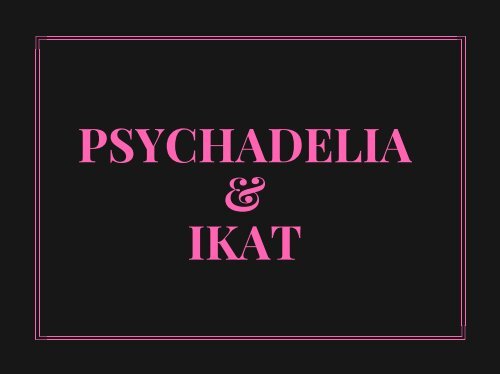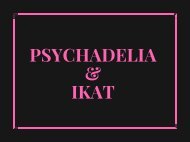prajwal
Create successful ePaper yourself
Turn your PDF publications into a flip-book with our unique Google optimized e-Paper software.
PSYCHADELIA<br />
&<br />
IKAT
is the subculture, originating in the 1960s, of people who often<br />
Psychedelia<br />
psychedelic drugs such as LSD, mescaline (found in peyote) and<br />
use<br />
(found in some mushrooms). The term is also used to describe a<br />
psilocybin<br />
of psychedelic artwork and psychedelic music. Psychedelic art and music<br />
style<br />
try to recreate or reflect the experience of altered consciousness.<br />
typically<br />
art uses highly distorted and surreal visuals, bright colors and full<br />
Psychedelic<br />
and animation (including cartoons) to evoke and convey to a<br />
spectrums<br />
or listener the artist's experience while using such drugs, or to enhance<br />
viewer<br />
experience of a user of these drugs. Psychedelic music uses distorted<br />
the<br />
guitar, Indian music elements such as the sitar, electronic effects,<br />
electric<br />
effects and reverberation, and elaborate studio effects, such as playing<br />
sound<br />
backwards or panning the music from one side to another.<br />
tapes<br />
PSYCHEDELIA
shapes seemed to relate to the unbinding of restrictions unloosed by the<br />
Flowing<br />
experience. The prevalence of tactile fabrics in hippie fashions<br />
hallucinogenic<br />
to the sense-enhancing properties of the acid trip. Most visible were its<br />
spoke<br />
in palette and imagery: equally provocative vibrating patterns and<br />
innovations<br />
Certain traditional motifs-the amoebalike crawl of Indian paisley, for<br />
colors.<br />
appropriated as psychedelic imagery. The accoutrements included<br />
example-were<br />
painting in Day-glo neon colors that recreated the incandescence of acid<br />
face<br />
But the principal topos of psychedelic fashion were portraits of light as it<br />
chimeras.<br />
fractured, made mobile by the lens of the acid trip. The awakened kineticism<br />
was<br />
light made flat surfaces seem to churn and roil. Colors bled, emulsified, and<br />
of<br />
PSYCHEDELIC FASHION<br />
merged kaleidoscopically.
X P A N D I N G T O D U B A I , S E O U L , A N D<br />
E<br />
A N C O U V E R I N 2 0 1 9 .<br />
V<br />
O U R L O C A T I O N S A S O F 2 0 1 8<br />
MELBOURNE / SYDNEY<br />
LONDON / TOKYO<br />
HONG KONG
culture in the United States is currently stereotyped with<br />
Rave<br />
of young adults wearing skin tight outfits and glow in the<br />
images<br />
accessories. The individuals in the subculture are seen from<br />
dark<br />
dominant culture as partygoers who are heavily drugged and<br />
the<br />
during the raves. That said, the rave culture originally came<br />
high<br />
the United States in the 1980s after becoming more known in<br />
to<br />
UK first. During the 1980s, “Ravers” differentiated themselves<br />
the<br />
other music based parties at the time by participating in a<br />
from<br />
RAVERS<br />
new sense of community not previously made before.
psychedelic experience is a temporary altered state of consciousness<br />
A<br />
by the consumption of psychedelic drugs (the best known of<br />
induced<br />
are LSD and psilocybin 'magic' mushrooms). The psychedelic altered<br />
which<br />
of consciousness is commonly characterised as a higher (elevated or<br />
state<br />
state relative to ordinary (sober) experience; for example, the<br />
transcendent)<br />
Benny Shanon observed from ayahuasca trip reports: "the<br />
psychologist<br />
very common with ayahuasca, that what is seen and thought<br />
assessment,<br />
the course of intoxication defines the real, whereas the world that is<br />
during<br />
PSYCHOGRAPHICS<br />
ordinarily perceived is actually an illusion."
DEMOGRAPHICS
title: Ravers – Subcultures and Sociology<br />
Article<br />
title: Haenfler.sites.grinnell.edu<br />
Website<br />
http://haenfler.sites.grinnell.edu/subcultures-andscenes/ravers/<br />
URL:<br />
title: Psychedelic 60s<br />
Article<br />
title: Graphic Design History<br />
Website<br />
https://visualartsdepartment.wordpress.com/psychedelic-<br />
URL:<br />
60s/<br />
Samantha Richards<br />
Author<br />
title: The Influence of Drugs throughout Music in the 1960s: The<br />
Article<br />
Era | World Music<br />
Psychedelic<br />
title: Blogs.longwood.edu<br />
Website<br />
https://blogs.longwood.edu/worldmusicsm/2013/04/29/the-influenceof-drugs-throughout-music-in-the-1960s-the-psychedelic-era/<br />
URL:<br />
HARVARD<br />
REFERENCING
Teri S Krebs<br />
Author<br />
title: Over 30 million psychedelic users in the United States<br />
Article<br />
URL:https://www.ncbi.nlm.nih.gov/pmc/articles/PMC3917651/figure/<br />
f1<br />
title: Psychedelic era<br />
Article<br />
title: En.wikipedia.org<br />
Website<br />
title: Edmsauce.com<br />
Website<br />
https://www.edmsauce.com/wp-<br />
URL:<br />
content/uploads/2014/07/Final-EDM-Infographic.png<br />
URL: https://en.wikipedia.org/wiki/Psychedelic_era



